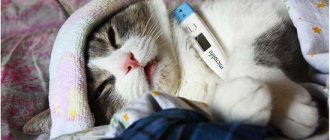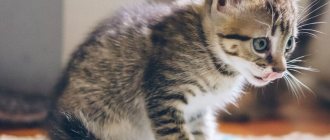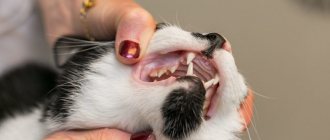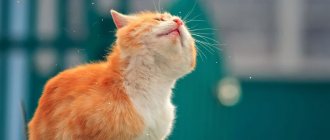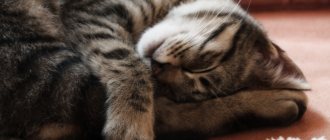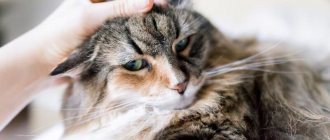5754Pavel
Representatives of the feline species spend most of their lives sleeping. These animals love to settle down in a cozy, safe place and choose the most comfortable position. Sometimes a cat twitches in its sleep. A person, seeing such movements, often begins to worry and wonders whether such a phenomenon is normal. What happens to an animal during sleep? What kind of movements during rest can be evidence of the development of pathologies? The answers to such questions are most interesting and important for animal owners.
Features of cat sleep
Scientists have conducted studies on cats' sleep. It was found that the normal sleep of this species of animals has 3 phases :
- superficial, it can be compared to a state of drowsiness, in which the individual is able to control the environment and danger;
- slow sleep, it is characterized by relaxation of the animal’s muscles, a decrease in blood pressure, slowing of breathing and heartbeat, the cat can make slow movements of the eyeballs under closed eyelids;
- REM sleep, usually lasts 6-7 minutes, during which changes occur - the breathing rate alternates between increasing and decreasing, the rhythm of the heart changes, blood pressure can increase, the eyes under the eyelids can move quickly, twitching of the paws, tail, ears, and whiskers occurs in sleep .
© shutterstock
Research has reliably confirmed that it is the rapid phase of sleep that is the period when the animal sees dreams filled with emotions, sights and sounds. The phases of sleep replace each other, and the cat’s behavior changes and corresponds to each of them.
Complete relaxation
To help your pussy fall into deep sleep, where twitching may sometimes occur, provide him with a sleeping area that maintains a constant, comfortable temperature. Cats especially feel safe in high places, where they are protected from various stimuli, such as other animals in the house.
At temperatures below 20 degrees, a cat may curl up and hide its nose under its tail, but at higher temperatures, it will tend to gradually relax its position.
Noticing that a cat is twitching in its sleep, the owner may be concerned about the well-being of the pet. If we are talking about an adult cat, suspicions are far from unfounded. Let's figure out why cats twitch in their sleep and what it may indicate if a cat twitches too much.
It was cats, or rather, their dreams, that made it possible to prove to the whole world that animals also plunge into the world of dreams. Moreover, scientists suggest that our pets' dreams are much richer and more dynamic than ours.
It all started when doctors began to study the phases of human sleep. To confirm their assumption that healthy people lose the ability to move during REM sleep, an experiment was conducted on a group of cats.
All animals had a small area of the brain removed, which was responsible for muscle atonia in the REM phase of sleep. After the animals were fully rehabilitated, the scientists' suspicions were corrected. The observed cats stood on their paws, walked confidently, and turned their heads, as if watching someone. While in a state of sleep, cats sniffed and turned their ears. The experiment proved that cats see, hear and touch dreams.
This is interesting!
A healthy, adult animal does not move during REM sleep, although rapid eye movements and slight twitching are considered normal.
With the development of medical equipment, it was possible to prove that during dreams, cats experience real emotions: fear, joy, excitement, aggression. Near the animals under observation, “pheromones” of a same-sex cat were sprayed and the observed one showed aggression. In the opposite case, when the scent of an animal of the opposite sex was sprayed, the observed behaved calmly or interestedly. That is, animals not paralyzed by the REM phase not only sensed the outside world, but also made natural, instinctive decisions. These observations led to the conclusion that in their dreams, cats see themselves and their surroundings very realistically.
This is interesting!
Experiments were carried out on cats, dogs and rodents. Cats surprised scientists by very naturally emitting hunting in their dreams. The dogs unexpectedly hinted at the animal essence, imitating the behavior of wild wolves. The rodents broke all records, because even in their sleep they were able to solve the tasks assigned to them.
The study of human and animal sleep continues. Of course, today it is no longer practiced to remove part of the brain for the sake of observation. To relieve atonia during the REM phase, blockades of part of the brain are used. Modern scientists are on the verge of a big discovery, since the experiments included observations of brain activity using highly sensitive scanners. There is no doubt that cats dream, but perhaps we will soon find out exactly what their dream world looks like. Already today, scientists have managed to find out that kittens see their first dreams while still in the womb.
What can a cat dream about?
What kind of dreams does a cat have? Scientists believe that an animal in a dream is capable of experiencing many pleasant and not so pleasant emotions, while at the same time seeing the real world around them and hearing its sounds :
- joy;
- aggression;
- fear;
- interest;
- hunting instinct.
It is hunting, the pursuit of prey, that, according to researchers, are the main plot lines of cat dreams. This leads to the conclusion that a sleeping cat’s paw twitches not because of illness, but because of the vivid pictures of life that the animal dreams of.
What causes seizures?
A cat twitches convulsively in its sleep due to the presence of an internal disease or a pathological process caused by parasites. The most common causes of seizures are:
- tumors;
- lymph inflammation;
- brain diseases;
- mental pathologies;
- deficiency of calcium or other substances;
- disturbances in the functions of the peripheral nervous system;
- infection by parasites and others.
When figuring out why cats twitch in their sleep, doctors identify specific diseases, including:
- non-purulent meningoencephalitis;
- cerebral ischemic encephalopathy;
- viral infectious peritonitis;
- toxoplasmosis;
- hyperparathyroidism;
- helminthiasis;
- ticks and fleas;
- excess medications or other drugs and additives in the blood;
- microstroke;
- lack of vitamin B;
- urolithiasis disease;
- renal failure;
- anemia.
Each of these diseases is very serious, but the most dangerous of them are meningoencephalitis, encephalopia and peritonitis.
Locomotor activity of kittens during sleep
Researchers explain why a kitten twitches in its sleep much more often, more energetically and longer than its adult relatives. They claim that a young cat between the ages of birth and one and a half years has a long REM sleep phase, which takes up to 80% of his total rest time. During the period of active growth and maturation in animals, the nervous system is in the stage of development and formation, therefore, during sleep, kittens experience more vivid emotions than sexually mature individuals.
Kittens are able to fall asleep in an uncomfortable place; often the position chosen for rest causes bewilderment among the owners due to its unnaturalness. After falling asleep, a young male cat begins to vigorously move and move its paws, often twitch its whole body, roll over and radically change its position in space. Sometimes his eyes may be slightly open, which is completely normal for a baby. The special structure of its visual organs suggests the presence of a third eyelid, which has the appearance of a transparent film that reliably protects the eyes. Kittens make sounds - they can meow with varying intensity, purr.
© shutterstock
The movement of a young sleeping cat can help to understand the storylines of his dreams - games with brothers and sisters, first fights, walks around the house and in nature, meeting other animals, for example, a dog or adult relatives, hunting birds, insects or rodents. Sleepy smacking and sucking movements are explained simply - the baby is enjoying delicious mother's milk.
Why do cats snore?
In order to give correct explanations, we will touch on the anatomical structure of cats, the basics of which any owner who respects his animal should know.
The picture clearly shows how long the cat’s trachea is. Through the trachea, air enters the cat's lungs, and through it it is expelled back. In a normal state, the number of inhalations and exhalations by a cat is 17-20. A very deep breath and a very long exhale! Air is passed through the vestibule of the trachea - the larynx.
But our cats, cats and kittens do not know how to growl - the hyoid is rigidly embedded in the larynx. But our pets can purr, forcefully pushing air through this natural bony barrier. They push air as they inhale, push it as they exhale, and therefore their purring process is continuous as long as the cat keeps the larynx in a relaxed state.
Kittens begin to make these sweet sounds as early as 5-7 days after birth, as soon as their little larynx begins to harden.
This is the first reason for snoring.
Do you know that pugs snore always and everywhere? The reason for this is the brachycephalic structure of the muzzle. If your cat has the same shortened nasal passages and unnaturally altered “facial” bones, then snoring for them is a natural, standard condition, because the air moves along an anomalous trajectory. They snore even while they are awake, but during sleep, when they relax, the snoring is especially pronounced.
Snoring can also occur in the most unimaginable positions that a cat takes during sleep. This position may seem comfortable to the cat, but it blocks the natural flow of air to the lungs - disrupts their circulation. The body reacts by drawing in more air and releasing carbon dioxide back. Result: we snore, we’re shaking!
We are not talking about obesity yet, but your cat’s “legs” have already become plump, the ribs are difficult to feel under the layer of subcutaneous fat, and the scruff of the neck is almost equal in width to the butt.
If until recently your funny kitten was cheerful and cheerful, but today he has a runny nose, drooling, sneezing, diarrhea, lack of appetite and snoring, then take him by the paw and take him to Aibolit. This one sign is enough to start seeing a doctor and start proper timely treatment, which will lead to the recovery of your naughty boy.
The cause of “fading” can be anything, from helminthic infestation and diseases of the gums and teeth, to serious diseases of the heart and other internal organs.
Having dealt with the main causes of snoring, let's try to find out why your cat twitches in its sleep, runs somewhere, shudders, twitches and even fights.
Motor activity during sleep of an adult cat
It is normal for a cat to twitch slightly during sleep once it has passed adolescence. Adaptation of an animal in the outside world and among “its own kind”, strengthening its nervous system, completing the construction of “owner-pet” relationships contributes to its psychological stability. The cat does not experience significant stress and therefore sleeps more peacefully.
In an adult, REM sleep is accompanied by:
- infrequent and not pronounced movements of the paws;
- twitching of the lip, mustache, ears;
- motor activity of the tail;
- rare screams, meows, growls.
If a cat older than two years old experiences emotions characteristic of a kitten in a dream, it is highly likely that it may be diagnosed with behavioral changes - increased nervousness, aggressiveness. It is difficult for such animals to adapt close to humans, and sometimes living together becomes impossible.
The importance of REM sleep in kittens
Kittens are able to dream while still inside the mother cat. Moreover, REM sleep provides neural stimulation, which contributes to the normal development of the brain and the entire nervous system of the embryo. The REM phase is extremely important for newborns and growing animals. Young animals experience dreams especially vividly. Kitty:
- can move its paws;
- beat the tail on the floor;
- roll over from side to side;
- move your ears and cheek muscles;
- breathe rapidly and meow.
Especially often, such violent reactions appear after outdoor games, stress or hunting experience. Running and tired, the baby may fall asleep in an unnatural position with his eyes half-open, which also should not cause concern. Firstly, kittens are like human babies and relax in their sleep without feeling discomfort, and secondly, the presence of a third eyelid in the corner of the eye helps protect the eyeball from drying out.
Features of the nervous system in kittens. The nervous system is formed simultaneously with the growth of the body, so unusual motor activity in kittens in the REM phase is completely normal.
If in adult animals the duration of REM sleep is 15-20 minutes, followed by a longer phase of slow-wave sleep, then in kittens up to six months the REM phase takes up 80% of the total rest time.
If the owner noted that the growing furry pet began to sleep more calmly and practically does not flinch in its sleep, then we can talk about the animal growing up and strengthening the nervous system. The period of stabilization of nervous functions is very individual and is determined by many factors, such as:
- Breed affiliation. In outbred cats, which generally mature faster, psychological maturation begins by 12 months, and representatives of large breeds, growing up to 2-2.5 years, demonstrate elements of childish behavior for quite a long time.
- Character. Temperamental and easily excitable animals require more time for the development of nervous processes than balanced and calm phlegmatic animals.
- Personal negative experiences and traumas. Stress can cause serious damage to the psyche. It has been proven that animals that have experienced fear and pain can return to this episode in their sleep, experiencing real nightmares.
Also watch the video why a cat twitches in its sleep:
When to Seek Veterinary Help
The special behavior of a cat in a dream may indicate the development of some dangerous pathological conditions in it. Cat owners should know their symptoms in order to prevent the development of diseases and not miss the time when treatment can be most effective.
© shutterstock
Seizure
In some situations, cats often twitch in their sleep, and such movements are similar in nature to convulsions. This condition requires immediate help for the pet, there is no time to waste, you must immediately start waking up the cat. The duration of the animal's awakening process must be assessed - a healthy animal is able to fully wake up quickly, within 15 seconds. If the process drags on against the backdrop of ongoing convulsions, the cat has difficulty getting out of sleep, remains half-asleep and lethargic - it requires a veterinary examination and, possibly, treatment.
Symptoms confirm seizure:
- labored breathing;
- the animal is unable to stand or simply raise and hold its head;
- cannot swallow saliva and chokes on it.
Situations are especially dangerous when, due to convulsive manifestations, the owner cannot wake up his cat or, after waking up, the animal loses consciousness. Such conditions indicate that the convulsions have not ended and the process may repeat. If the seizure is of a recurring nature, the symptom may indicate pathologies of the nervous system, the possibility of the development of tumor processes in the pet’s brain. Often, convulsions in a dream end in the death of the cat.
Cat during pregnancy and after birth
Maximum attention to the cat's behavior from the owner is required during her pregnancy and after the birth has occurred. It is during periods associated with the expectation and birth of offspring that it is necessary to monitor the female’s sleep patterns, movements accompanying rest, and monitor the possibility of seizures.
A seizure may occur while the cat is resting after giving birth. It is the main symptom of the development of pathology - postpartum preeclampsia. Its other symptoms are :
- severe anxiety of the animal, excitement, or vice versa, falling into an inhibited state;
- body temperature rises;
- breathing and heart rhythm disturbances;
- salivation increases;
- loss of consciousness occurs.
© shutterstock
Convulsions begin with light muscle contractions, which then become prolonged - the cat may take unnatural poses, fall on its side, or lose motor coordination. The condition requires urgent professional assistance.
The tail is an indicator of the cat's emotions
Most often, a cat twitches its tail to communicate its mood. Depending on how and how actively she begins to move it, the owner can guess what emotions his pet is experiencing:
Excess of feelings. Often a cat's tail twitches when a person pets the animal. Combined with purring, this means that the cat is absolutely happy
He is satisfied with the owner's attention and hurries to tell him about it. Interest in something
The cat's tail stands upright when the pet is happy and expects something pleasant (for example, it is time to feed). But when he begins to smoothly move it up and down, this is a sign that the cat is interested in some thing or object. He will walk around it, sniff it, try to catch it. It could be anything: a fly flying by, a new toy, a bag of groceries. Irritation. Experiencing such emotions, the cat begins to rhythmically jerk its tail left and right. This is how she shows that the current situation is unpleasant for her. For example, a pet may feel that the timing for affection is poorly chosen. Fear, panic. It is not difficult for a person to determine that a cat is very scared - the animal twitches its tail, hitting it on the floor with all its force. His whole body is shaking, his pupils are dilated, and the cat itself can make plaintive sounds. At such moments, the pet should not be touched. The best thing the owner can do is to eliminate the situation or object that frightened the animal.
Sometimes cats not only twitch their tail, but also their back. There are several reasons that cause this animal behavior. A cat constantly jerks its tail and rear part of its body in the following cases:
- during puberty she has a sexual desire, but there is no way to satisfy it;
- the animal has fleas;
- the pet has been struck by cancer - a tumor has arisen in the spinal cord or brain.
In addition, the cat may twitch its back and tail due to neurosis. In veterinary medicine it is called hyperesthesia syndrome. Suffering from this disease, the animal begins to lick its paws, back, and anus for hours. His fur becomes wet from saliva and does not have time to dry before the next wash. Such actions of the pet indicate nervous exhaustion, lack of attention from the owner, and severe stress.
According to available data and statistics, most cats regularly experience small twitches while sleeping. Some experts believe they may be similar to what people experience during REM eye movement sleep. During rapid eye movement, people dream and experience a deep sense of pleasure in sleep.
Reasons why a cat trembles
Tremor or trembling in a pet is not always a sign of illness
. If a cat is trembling, then it is almost impossible not to notice this state of the animal. There are several main reasons that can cause a pet to tremble in apparent absolute health:
- an animal's reaction to an external stimulus represented by cold
. This reason is the most harmless, but can cause a number of quite serious consequences, including severe hypothermia of a pet. It is especially important to control the temperature in the room when keeping hairless breeds and cats with short hair. In cool weather, it is necessary to reduce walks with the animal to a minimum or completely eliminate its stay on the street; - an animal's reaction to severe fright or any stressful situation
. Quite often, this situation arises when there is a sudden change in diet, the appearance of strangers or unfamiliar animals in the house, as well as when being transported to a new place of residence. In this case, it is enough to eliminate all factors that provoke trembling as quickly as possible and calm the pet; - reaction to a joyful event
. Trembling in an animal can also cause quite positive emotions, including joy from the appearance of the owner or pleasure from games, affection and receiving favorite foods; - reaction to sexual arousal
. The appearance of fairly distinct trembling can be caused by a state of sexual arousal in a cat or a cat in heat. In almost all representatives of the cat family, all senses are very characteristically heightened and behavioral characteristics change greatly during the period of sexual arousal, therefore, it is advisable to sterilize or castrate animals not intended for breeding; - natural processes
. Actively occurring in the body of a sleeping pet, they can also be accompanied by trembling of the body and limbs.
Important!
Particular attention is required to frequent, quite strong tremors of the body and limbs, which occur in a pet regularly and for no apparent reason.
In this case, it is necessary to deliver the cat to a veterinary institution as quickly as possible, where a full range of basic, most informative diagnostic measures will be carried out aimed at identifying the cause of the pathological condition.
Health problems in newborn kittens
The most common intestinal parasites found in kittens. Other health problems in young kittens include infectious diseases such as respiratory infections and congenital diseases.
Fading kitten syndrome occurs when a kitten does not grow. If you notice that one of the kittens is usually more lethargic and sleeps much more than its siblings, this may be a sign of the syndrome.
This kitten requires immediate attention from a veterinarian who specializes in kitten care.
When twitching is normal
The question that most often arises is: why do you twitch when you fall asleep? The answer may be so-called physiological or benign myoclonus. Sometimes, when falling asleep, a person imagines that he is flying or falling into a hole. A sharp and strong relaxation of muscles is not always correctly perceived by our brain.
After all, absolute relaxation is death. So our brain transmits a signal to check whether the body is alive. The impulse rushes to the muscles, “revitalizing” the body and providing a tremor, which is a kind of signal about successful activity. This is why people twitch during sleep. Therefore, benign myoclonus is often observed in children and those people who fall asleep very quickly and without problems.
Phenomena that do not require intervention also include myoclonus in children and infants. Physiologists say that the sleep phases of babies are not similar to those of adults. And if for parents the deep sleep phase lasts 2-3 hours, then for their child it can only be an hour, alternating with shallow sleep. When transitioning from one phase to another, the baby begins to twitch and frighten the parents. Although there is no need to worry at all.
How to get a restful sleep
Useful tips to normalize sleep and get rid of involuntary body movements:
- you need to identify the cause of the disease and, if necessary, seek help from a specialist;
- take sedatives if there are no contraindications;
- beware of hypothermia;
- add foods rich in macronutrients to your diet;
- reduce consumption of tea and strong coffee;
- do exercises in the morning, take walks in the fresh air before going to bed;
- accustom yourself to go to bed and get up at the same time;
- choose a comfortable bed with orthopedic accessories.
These rules are useful only if a person twitches in his sleep and this does not affect the person’s sleep in any way and does not bring much discomfort. If you have serious illnesses, it is impossible to cope with the disorder on your own; it is better to seek help from a qualified specialist.
Twitching in sleep or sleeping myoclonus is a syndrome that is manifested by muscle contraction (also called positive myoclonus) or a decrease in their tone (negative) during the period of maximum possible relaxation. It is worth noting that twitching can affect both the body as a whole and its individual parts (usually the arms and legs).
The phenomenon of night twitching is common in both the adult population and the younger population, including infants. It is believed that about 70% of people twitch in their sleep. But most people don’t know about this, since myoclonus does not contribute to awakening and people don’t remember about it in the morning. Therefore, household members often pay attention to him and pester him with the question of why the person slept so restlessly at night.
There is also another definition for nocturnal twitching - hypnagogic twitching. It was first described by physiologists as a simultaneous tension of all nerves in a bundle directed to a particular muscle.
Factors
- Another possible factor for tremors in a cat may be uncomfortable posture . Cat muscles and joints are capable of reacting this way to being in an uncomfortable position for a long time.
- An equally significant fact can be stress or previously experienced fear . A possible reason is the animal’s excessive activity during hunting and games. As well as the presence of injury or bruise.
The fact that a cat is trembling may be due to stress.

